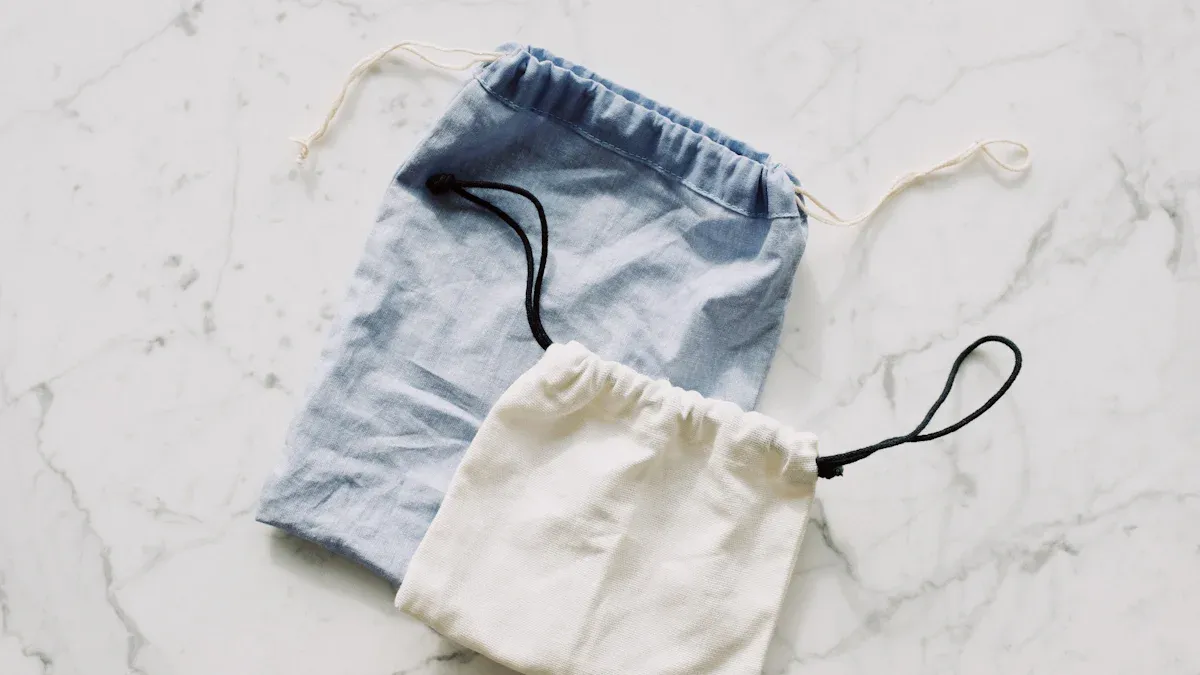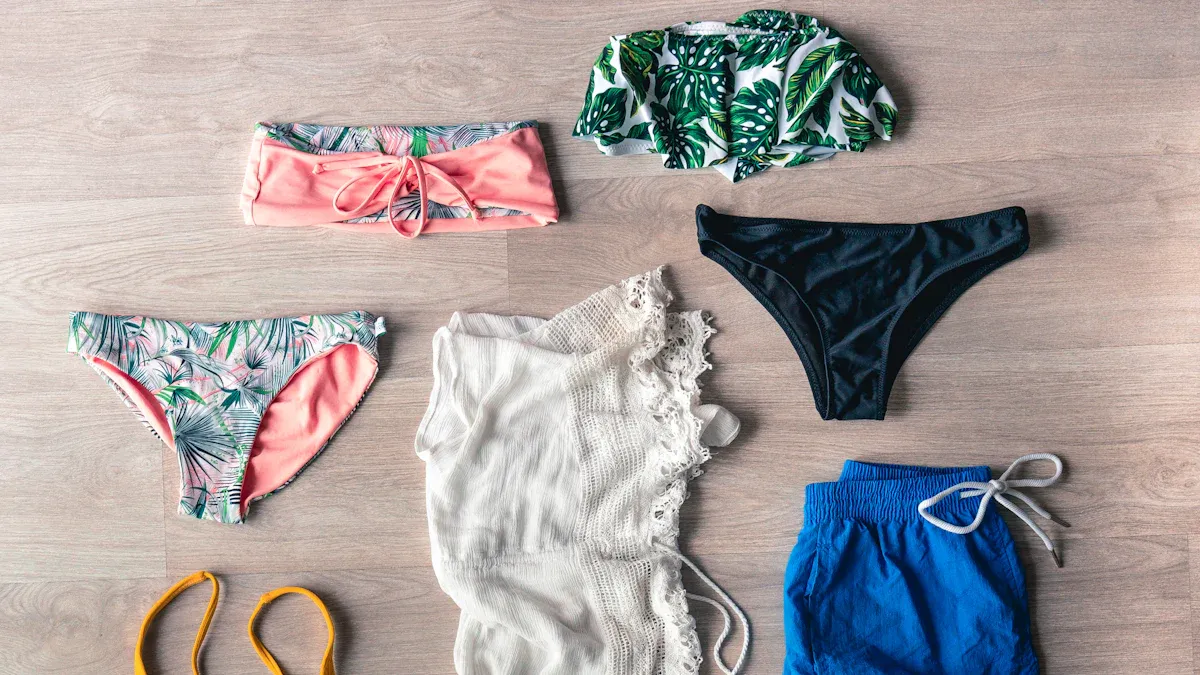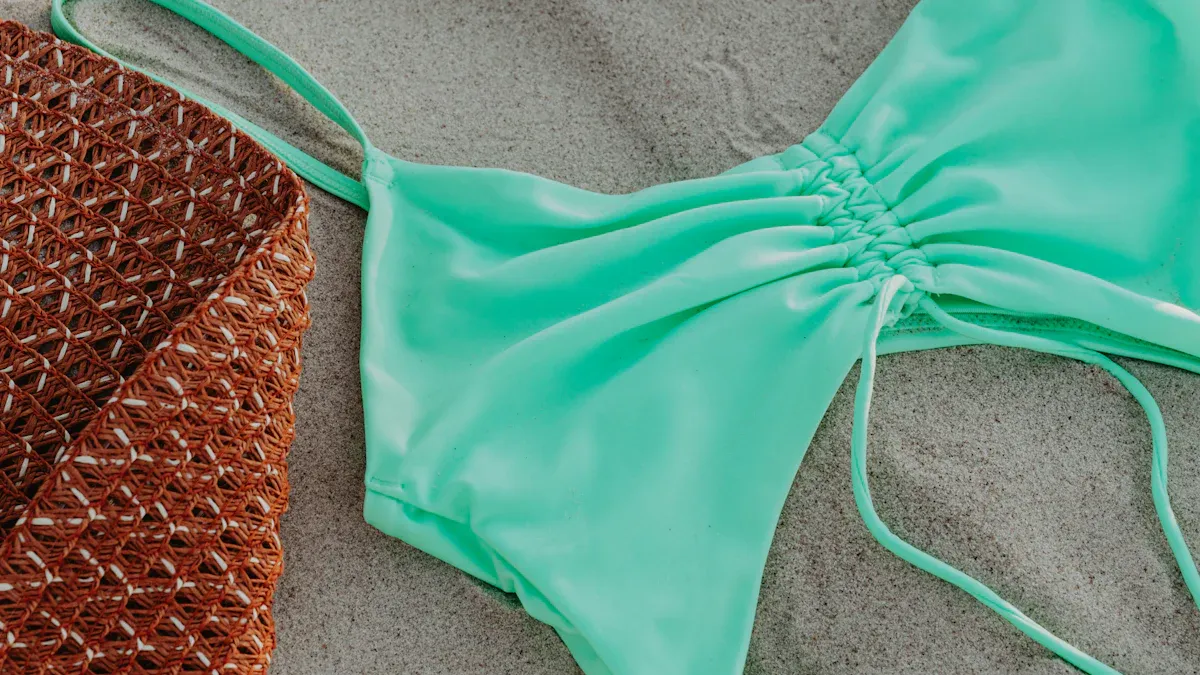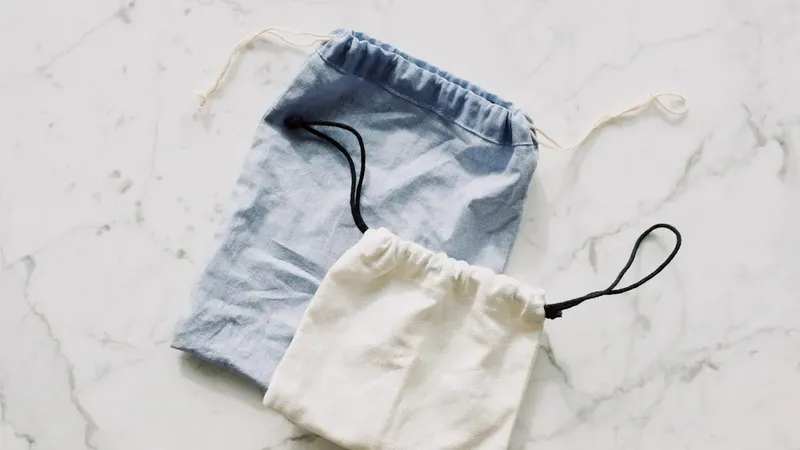
You can pick from many eco-friendly swimwear fabrics when working with a custom swimwear manufacturer. Some choices include recycled polyester, econyl, repreve, hemp, bamboo, organic cotton, tencel, and deadstock. More people are seeking sustainable swimwear now, with over 38% of swimwear made from recycled or sustainable materials. Research shows that buyers want swimwear that feels good, lasts long, and is better for the planet. As a custom swimwear manufacturer, you have the opportunity to help create new ideas by choosing fabrics that protect nature and perform well.
Key Takeaways
Pick eco-friendly fabrics like recycled polyester, ECONYL, hemp, and bamboo. These help protect the planet. They also make swimwear strong and comfy. Look for certifications like OEKO-TEX and GRS. These show your swimwear is safe and really sustainable. Take care of your swimwear by washing it gently. Dry it in the shade to help it last longer. This also helps it keep its shape. Custom swimwear makers can use green materials and fair practices. They can also use eco-friendly printing to make special, sustainable designs. You can balance eco-friendliness and performance. Choose strong recycled blends and test fabrics for stretch, strength, and comfort.
Top Eco-Friendly Fabrics

Recycled Polyester
Recycled polyester is a popular eco-friendly swimwear fabric. It is made from plastic waste like PET bottles and old clothes. Ocean plastics are also used. Workers collect, sort, and clean the plastic. Then, they turn it into soft yarn. Brands such as Repreve and Econyl use this process. They make strong swimwear fabrics.
Making recycled polyester uses less energy than new polyester. It also creates fewer greenhouse gases. This helps keep plastic out of landfills and oceans. Swimwear made from recycled polyester dries fast and does not wrinkle. It lasts a long time. It may not be as tough as new polyester. But it still works well for swimwear. Both types can release microplastics when washed. Recycled polyester is still better for the planet.
Tip: Check for OEKO-TEX and Global Recycling Standard (GRS) labels. These show your recycled polyester swimwear fabrics are safe and eco-friendly.
ECONYL®
Econyl is a special nylon made from waste. It uses things like fishing nets, old carpets, and fabric scraps. The process breaks down nylon waste. Then, it rebuilds it into new fibers. The quality stays the same. You can recycle Econyl many times.
Swimwear made with Econyl is very strong. It resists chlorine and gives UPF 50+ UV protection. It lasts a long time. Vita by Carvico uses 78% Econyl and 22% elastane. This mix stretches well and feels comfy. These swimwear fabrics do not get damaged by sunscreen or oils. They are great for people who swim often. Econyl has UL and Cradle-to-Cradle certifications. This shows it is made in a green way.
Feature | Vita by Carvico (Econyl) | Regular Swimwear Fabrics |
|---|---|---|
Chlorine Resistance | High | Varies |
UV Protection | UPF 50+ | Often lower |
Durability | Long-lasting | Varies |
Environmental Impact | Lower | Higher |
Repreve
Repreve is another top recycled polyester brand. It uses plastic bottles and factory waste to make swimwear fabrics. This process cuts greenhouse gases by up to 60%. It also uses 66% less fossil fuel. Repreve swimwear fabrics are light and let air through. They dry quickly. They protect you from UV rays and fight odors.
You can find Repreve swimwear in many colors and styles. This makes it easy to design your own look. The fabric is tough and simple to clean. You can wear it many times. Repreve has GRS certification. This means your swimwear is truly eco-friendly.
Hemp
Hemp is a natural fiber that grows fast. It needs little water and no pesticides. Farmers mix hemp with organic cotton and elastane. This makes swimwear fabrics soft and stretchy. Hemp helps soil stay healthy. It does not make microplastic pollution.
Hemp swimwear fabrics are strong and block UV rays. They also kill germs. But they soak up water and dry slowly. So, they are best for casual swimwear. To keep hemp swimwear nice, wash it gently. Do not use fabric softeners. Dry it in the shade.
Hemp is tough and good for the earth.
Mixing with cotton and elastane makes it comfy.
Careful washing helps your swimwear last longer.
Organic Cotton
Organic cotton comes from plants grown without bad chemicals. No pesticides are used. This way uses 91% less water than regular cotton. It also keeps soil healthy. Organic cotton swimwear fabrics are safe for sensitive skin. They break down naturally.
You get swimwear that breathes and soaks up moisture. It feels soft and comfy. Organic cotton is stronger than many fake materials. Your swimwear will last longer. Picking organic cotton helps farmers and the planet.
Environmental Aspect | Conventional Cotton | Organic Cotton |
|---|---|---|
Pesticides | High | None |
Water Usage | High | Low |
Soil Health | Degrades | Improves |
Carbon Footprint | High | Low |
Bamboo
Bamboo grows very fast. It needs little water and no pesticides. This makes it a good choice for swimwear fabrics. New ways to make bamboo fabric use closed-loop systems. These cut down on chemical waste.
Bamboo swimwear fabrics are soft and let air through. They pull moisture away from your skin. They are safe for people with allergies. They also kill germs. Bamboo fabric breaks down naturally. OEKO-TEX often certifies it as safe and green.
It keeps you cool and dry when you move.
Plant dyes can make bamboo swimwear even greener.
Tencel
Tencel is made from wood pulp. The trees come from forests that are certified. The process uses a closed-loop system. This recycles almost all water and chemicals. Tencel has OEKO-TEX and GOTS certifications. This proves it is safe and eco-friendly.
Tencel swimwear fabrics let air through and pull moisture away. They feel soft and do not pill. They keep their shape after many wears. Tencel breaks down and can be composted. It goes back to nature when you are done with it.
Property | Description |
|---|---|
Breathability | High |
Durability | Strong, keeps shape |
Softness | Silky smooth |
Care | Needs gentle washing, avoid heat |
Deadstock
Deadstock fabric is leftover from factories and mills. Instead of throwing it away, you can use it for new swimwear. This cuts down on waste and helps the planet.
Deadstock swimwear fabrics come in special patterns and colors. But there may not be much of each kind. You might need to change your designs to fit what is available. Using deadstock helps the earth by using what is already made.
Deadstock cuts down on textile waste.
You save money and get cool designs.
Note: Custom printing on deadstock swimwear fabrics helps cut waste. You only use what you need for each order.
Why Fabric Matters
Performance Needs
Picking the right fabric is important for swimwear. It helps your suit last longer. It also makes you feel more comfortable. Swimwear should stretch and fit your body well. It needs to handle sun, salt, and chlorine. Polyester and nylon are common synthetic fibers. They do not lose their shape in water. They also resist chlorine. Elastane, or spandex, makes swimwear stretchy and comfy. But it can wear out faster in pools. Mixing polyester and elastane gives you both strength and stretch.
Here is a simple chart that shows how fabrics work for swimwear:
Fabric | Stretch | Durability | Comfort | Best For |
|---|---|---|---|---|
Nylon | High | Medium | High | Fashion swimwear |
Polyester | Medium | High | Medium | Competitive swimwear |
Elastane | Very High | Low (alone) | High | Blended for flexibility |
PBT | Medium | Very High | Medium | Professional swimwear |
Natural fibers like cotton and hemp are not great for swimwear. They soak up water and dry slowly. If you want your suit to last, pick the right fabric for your activity. Take care of your swimwear to help it last longer. Recycled polyester and other green fabrics now work just as well as regular ones.
Environmental Impact
The fabric you pick matters for the earth too. Nylon and polyester come from oil. They do not break down. They can pollute the planet for a long time. Washing these fabrics can send microplastics into the water.
Sustainable swimwear fabrics help fix these problems. Recycled polyester, ECONYL, and organic cotton use waste to make new fabric. They use things like plastic bottles and fishing nets. This means less trash in landfills and oceans. Making these fabrics uses less water and energy. Many brands also treat workers fairly and keep them safe.
When you choose sustainable swimwear, you help the earth and support fair jobs.
Eco-friendly swimwear lasts a long time. It feels good and helps protect the planet.
Role of Custom Swimwear Manufacturer
Sustainable Practices
Custom swimwear manufacturers can help the planet. You can pick eco-friendly materials like ECONYL, REPREVE, recycled polyester, and hemp. These fabrics come from things that are recycled or from nature. Many manufacturers try to get their fabric in a fair way and make less waste. Some factories use solar power to make clean energy. You can help by being honest about how you make swimwear. Helping local people and giving to ocean groups shows you care.
Pick recycled and natural fabrics for swimwear.
Get fabric in a fair way and make less waste.
Use clean energy if you can.
Help local people and protect the environment.
Make small batches to stop extra waste.
Using green ways to make swimwear helps the earth and makes customers trust you.
Custom Printing on Eco Fabrics
You can make swimwear special by printing on eco-friendly fabrics. Many manufacturers use water-based inks. These inks are better for people and the earth. Printing on deadstock fabric also stops waste. You only use what you need for each order. This keeps extra fabric out of the trash. You can offer lots of colors and patterns and still be green. Custom swimwear made this way is different and helps the planet.
Printing Method | Environmental Impact | Best For |
|---|---|---|
Water-based inks | Low | Eco-friendly swimwear |
Digital printing | Low waste | Custom swimwear designs |
Traditional dyes | Higher | Mass production |
Certifications and Standards
Certifications help you pick the best eco-friendly fabrics. GRS checks if fabrics really use recycled stuff. OEKO-TEX makes sure fabrics are safe and have no bad chemicals. These labels show your swimwear is safe and made with care. Many manufacturers use these certifications to meet high standards. They help you show your swimwear is made the right way. Customers trust brands that use certified fabrics.
Certifications like GRS and OEKO-TEX help you choose safe and green fabrics for custom swimwear.
Fabric Comparison

Sustainability
You want swimwear that is good for the earth. Recycled swimwear fabrics like ECONYL and Repreve use old fishing nets and plastic bottles. These materials keep trash out of the ocean. They also help lower pollution. Plant-based swimwear fabrics, like hemp and bamboo, come from plants that grow back fast. These fabrics break down faster than synthetic ones. Some fabrics, like organic cotton, use less water and no bad chemicals. Picking swimwear with certified materials helps workers and keeps factories safe. Many brands now make fewer pieces that last longer.
Fabric Type | Sustainability Features |
|---|---|
Recycled Fabrics | |
Plant-Based Fibers | Biodegradable, renewable, natural antibacterial |
Biodegradable Fabrics | Break down quickly, reduce microplastic pollution |
Picking eco-friendly swimwear fabrics helps the planet and gives workers better jobs.
Performance
You want swimwear that fits well and lasts a long time. Recycled swimwear fabrics like ECONYL and Repreve stretch well and dry fast. They also resist chlorine and UV rays. These features make them as good as regular swimwear. Plant-based swimwear fabrics feel soft and comfy. They often need to be mixed with elastane to stretch and hold their shape. Natural fibers like cotton and hemp dry slowly and may not last long in water. Polyester and nylon are very strong, but they do not break down in nature. Spandex makes swimwear stretchy but needs gentle washing.
Recycled swimwear fabrics: Strong, stretchy, dry fast
Plant-based: Soft, comfy, may need blends to fit best
Traditional synthetics: Tough, but not good for the earth
Customization
You can make special swimwear with many green choices. Recycled swimwear fabrics are great for custom prints, straps you can adjust, and styles you can flip inside out. Brands use digital printing and water-based inks to help the earth. Plant-based swimwear fabrics are comfy and stylish, but you may need to mix them for the best fit. Deadstock swimwear fabrics give you rare colors and patterns, but you might not get much of each kind. Certifications like OEKO-TEX and GOTS show your custom swimwear is safe and high quality.
Fabric Type | Customization Options |
|---|---|
Recycled Fabrics | Print-on-demand, adjustable features, ethical production |
Plant-Based Fibers | Blends for comfort and style |
Deadstock | Unique patterns, limited quantities |
You can pick swimwear fabrics that are green, work well, and look cool for your custom swimwear line.
Challenges and Considerations
Availability and Cost
Eco-friendly swimwear can cost more than regular swimwear. Premium materials like recycled nylon and bamboo need special ways to make them. These ways take more time and use more resources. Small factories and hand dyeing also make prices go up. Sometimes, it is hard to get enough fabric for swimwear. You may want a certain color or print, but it is not easy to make every piece look the same. Prices are higher because workers get fair pay for their work.
Supply chain problems can make eco-friendly fabrics hard to find.
Custom designs and extra features make swimwear harder to make.
Tip: Ask your manufacturer about saving money by using deadstock fabrics or buying more at once.
Care and Longevity
Eco-friendly swimwear needs special care to last longer. Cotton and hemp soak up water and can lose their shape. Wash these gently and do not twist or wring them. Recycled polyester and nylon last longer, but you should wash them by hand and dry them in the shade. Use mild soap and skip fabric softeners to keep your swimwear strong. Polyester and PBT do not get damaged by chlorine and keep their shape. Nylon is soft but fades faster and does not stretch as long.
Fabric Type | Care Tips | How Long It Lasts |
|---|---|---|
Natural Fibers | Hand wash gently, air dry, no wringing | Not as strong, may sag or lose shape |
Recycled Polyester | Hand wash, little soap, dry in the shade | Strong, resists chlorine, good for the planet |
Polyester | Rinse after use, hand wash, no sunlight | Very strong, keeps shape well |
Nylon | Rinse, hand wash, no sunlight | Soft, fades faster, not as good with chlorine |
PBT | Same as polyester and nylon | Strong, dries fast, good for lots of use |
Note: Rinse your swimwear after swimming and dry it in the shade. This helps your suit last longer.
Balancing Eco and Performance
You want swimwear that is green and works well. Some eco-friendly fabrics do not stretch or resist chlorine as much as regular ones. You can pick blends with recycled polyester or nylon and elastane for better fit. Test fabrics for stretch, color, and how they handle chlorine and sun. Work with suppliers who know about green and strong fabrics. Check the quality often when making swimwear to keep it high.
Test swimwear for fit, stretch, and how it handles chlorine and sun.
Pick linings and parts that help the suit keep its shape and not show through.
Choose fabric based on how the swimwear will be used.
You can have eco-friendly and strong swimwear by picking the right blends and working with skilled makers.
You can pick from many eco-friendly swimwear fabrics. Some examples are recycled polyester, ECONYL, hemp, and bamboo. Each fabric has its own good points. Some protect you from the sun. Others last a long time or dry quickly. When you choose a fabric, think about how you will use your swimwear. Make sure the fabric fits what you need. Check if it stretches well and is strong. See if it looks good with prints. Ask for samples so you can touch and try them. Look for certifications like GRS or OEKO-TEX to be sure the fabric is safe.
A certified custom swimwear manufacturer follows strict rules. They check quality, treat workers fairly, and use green ways to make swimwear. This helps you get custom swimwear that looks cool, lasts long, and is good for the earth.
FAQ
What makes a swimwear fabric eco-friendly?
Eco-friendly swimwear fabrics use recycled stuff or natural fibers. Picking these helps cut down on waste and pollution. Look for labels like OEKO-TEX or GRS to know your fabric is green.
Can eco-friendly swimwear last as long as regular swimwear?
Eco-friendly swimwear can last if you take care of it. Wash your suit by hand and let it dry in the shade. Recycled polyester and ECONYL® fight chlorine and UV rays, so they stay strong.
Are there any downsides to using natural fibers in swimwear?
Natural fibers like hemp and cotton feel soft and gentle. These fabrics dry slowly and might lose their shape in water. Mixing them with elastane helps them fit better and last longer.
How do I know if a fabric is truly sustainable?
Look for trusted labels. OEKO-TEX, GRS, and GOTS mean your fabric is safe and follows green rules. You can ask your maker for proof before you buy.
Can I customize eco-friendly swimwear with prints and colors?
You can put custom prints on recycled polyester, ECONYL®, and deadstock fabrics. Water-based inks and digital printing make bright colors and patterns. You help the earth and get cool swimwear.
